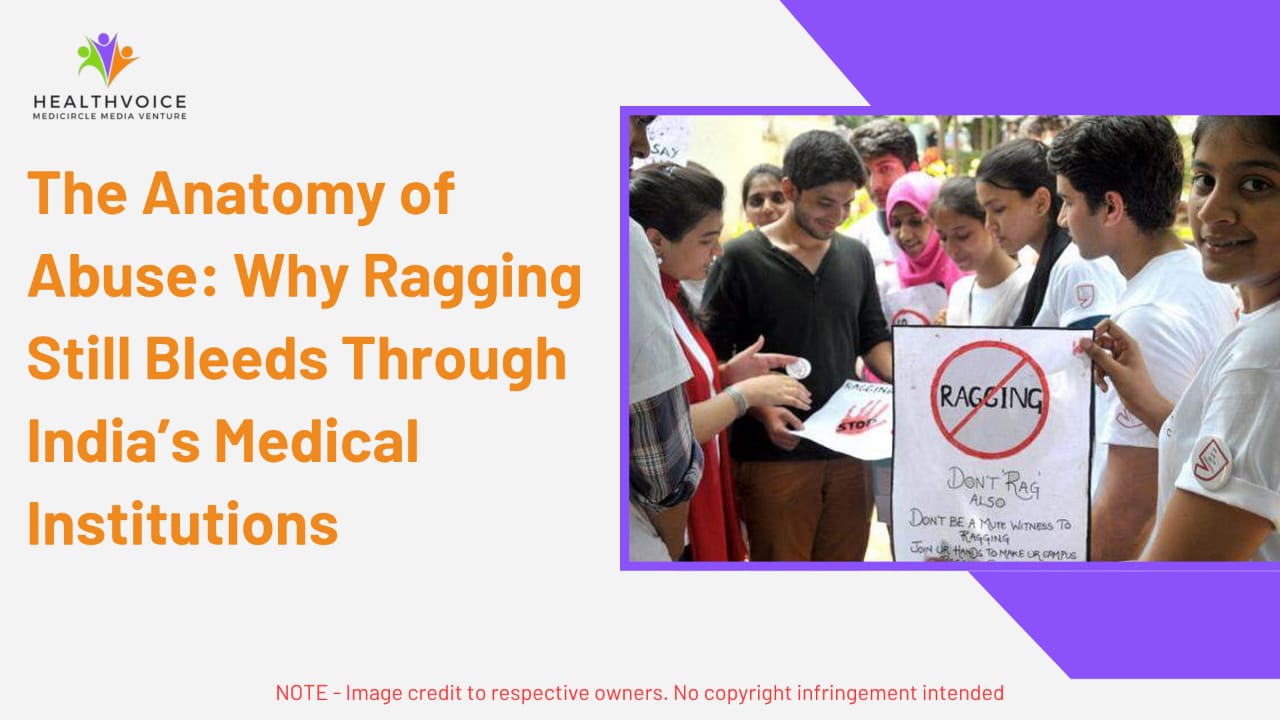The Anatomy of Abuse: Why Ragging Still Bleeds Through India’s Medical Institutions
The High Court’s refusal to dismiss the case sends a strong message that justice will not be sacrificed for reputation. It signals a slow but necessary shift from complacency to accountability.

There are moments when a profession built on compassion must confront its own cruelty. The recent decision by the Gujarat High Court to dismiss the discharge plea of a medical student accused of participating in a fatal ragging incident at GMERS Medical College and Hospital has once again brought to light the deep-rooted menace of ragging within India’s medical education system. Behind the white coats and solemn oaths, there lies a reality that too often escapes scrutiny of a culture that has allowed psychological torment and physical abuse to masquerade as tradition.
The tragedy dates back to November 16, 2024, when an 18-year-old first-year MBBS student at GMERS Medical College, Patan, lost his life after allegedly being forced to stand for hours during a so-called “introduction” session organized by his seniors in the hostel. What began as an act of casual authority turned into horror when the young student collapsed and was later declared dead at the hospital. The incident shook the medical community, leaving behind questions about ethics, humanity, and the systemic failures that continue to haunt medical campuses across India.
The Gujarat High Court’s decision, delivered by Justice R. T. Vachhani, makes one thing clear that the allegations are grave and cannot be dismissed at a preliminary stage. The student, along with fourteen others, faces charges of culpable homicide not amounting to murder, unlawful assembly, illegal detention, and using obscene language. The defense tried to paint the incident as an unfortunate coincidence, arguing that the deceased had suffered a cardiorespiratory arrest triggered by an epileptic seizure, unconnected to the alleged ragging. But the court, after examining witness statements and available evidence, refused to absolve the accused, noting that the revisional powers of the court could not be used to dilute a case involving such serious allegations.
What stands out is not just the judicial reasoning but the moral reflection it compels. How does a profession meant to heal end up harming its own? Ragging in medical colleges has long been justified under the garb of “orientation” or “bonding.” It is said to build resilience, to humble the newcomers, and to establish camaraderie among peers. But the truth is darker. It breeds fear, breaks confidence, and, as seen repeatedly, costs lives. The thin line between discipline and abuse disappears when power becomes the motive.
In this case, the first-year students were allegedly summoned to a hostel room by a group of seniors who made them stand for over three hours, forcing them to sing, dance, and use abusive language, denying them permission to leave. Witnesses have described the atmosphere as one of humiliation and mental pressure. The young victim, unable to bear the strain, fainted and never regained consciousness. What was meant to be a night of “fun” turned into a nightmare that ended a promising medical career before it even began.
The defense counsel’s argument that CCTV footage proved non-involvement reflects a broader trend of denial and justification. Ragging thrives in silence, protected by collective complicity. Every batch knows it happens, every institution knows it exists, yet the cycle continues. Students are hesitant to complain for fear of being branded weak or disloyal. Administrations, wary of reputational damage, prefer quiet settlements over disciplinary action. The result is a culture where cruelty becomes normalized, and accountability remains rare.
The High Court, while acknowledging that the postmortem report suggested an epileptic seizure as the immediate cause of death, also noted that such an episode could have been provoked by extreme stress induced by the events of that night. This acknowledgment is crucial, as it bridges the gap between medical reasoning and moral responsibility. Stress, humiliation, and exhaustion can act as silent killers. For a young student far from home, facing pressure from both academics and peers, such experiences can have devastating consequences.
The decision to send the case to trial ensures that the truth will be examined under the lens of justice. But beyond the legal outcome lies the ethical reckoning for the medical community. It forces introspection on what kind of doctors the system is producing, trained to empathize with suffering or those desensitized to it through systemic cruelty. Every time a case like this surfaces, it chips away at the nobility that medicine represents.
Over the years, numerous committees, regulations, and anti-ragging laws have been established to prevent such incidents. The University Grants Commission (UGC) and the National Medical Commission (NMC) have issued clear guidelines, mandating strict action against offenders and immediate suspension upon verified complaints. Yet, these measures remain effective only on paper in many colleges. The enforcement often falters due to lack of courage or commitment from institutional heads.
In medical colleges, where hierarchy defines every level of interaction from professors to residents, seniors to juniors ragging finds fertile ground. Seniors often mimic the authoritarian patterns they once suffered, perpetuating the same violence they once endured. What begins as imitation becomes tradition. The logic of “we went through it, so must you” keeps the cycle alive. In the process, empathy i.e. the very core of medical ethics gets eroded long before students even enter hospitals as professionals.
The case of GMERS Patan is not the first, and sadly, it may not be the last. Across India, countless students have faced verbal abuse, physical assault, and psychological torment under the guise of discipline. Some have dropped out; others have lost their lives. In each instance, investigations reveal the same pattern of neglect, delay, and denial. Institutions react only when the media intervenes or when tragedy strikes. By then, it is too late for the victims.
The Gujarat High Court’s firm stance should serve as a message to all medical institutions: negligence toward ragging is no longer an administrative oversight it is complicity. Colleges must create transparent grievance redressal systems that students can trust. Mental health support should be as essential as anatomy lessons. Faculty must be trained to detect signs of distress among students, and peer mentoring programs should replace the outdated, abusive initiation rituals that claim to build “bonding.”
Medical education is not just about knowledge; it is about nurturing character. A doctor’s first patient is his or her own conscience. When that conscience is desensitized through fear or arrogance, medicine loses its purpose. Ragging is not an act of tradition it is an act of betrayal to the very values that define this profession. The GMERS tragedy exposes that betrayal in its most heartbreaking form.
The dismissed plea also marks a victory for justice that tells victims their suffering matters. It assures grieving parents that their child’s death will not be buried under excuses. It reminds every senior student that leadership comes from empathy, not intimidation. The court’s decision reinforces that in a society aspiring for progress, accountability is the cornerstone of reform.
For doctors and medical educators, this case is a mirror. It reflects the need to humanize medical training. Compassion cannot be taught through textbooks; it must be lived through example. When future doctors learn cruelty from their peers, how can we expect kindness in their practice? When authority is misused in hostels, it erodes respect for hierarchy in hospitals. The seeds of professionalism are sown in the classroom and the hostel corridor; if they are poisoned early, the harvest will always be bitter.
The young student who died at GMERS Patan will never finish his degree, never wear his white coat, and never save a life. His story, however, must save others. His tragedy should awaken every dean, every senior, and every policymaker to the reality that ragging is not a phase it is a crime. And crimes deserve punishment, not excuses.
There is a haunting irony in this entire episode. Those who dream of curing pain ended up causing it. Those meant to preserve life became instruments of its destruction. It is a chilling reminder that without humanity, medicine is just a science, not a calling. The High Court’s refusal to dismiss the case sends a strong message that justice will not be sacrificed for reputation. It signals a slow but necessary shift from complacency to accountability.
Ragging is a wound that refuses to heal because it is inflicted by those meant to protect. Each act of humiliation leaves behind invisible scars, eroding confidence and shattering trust. For the family of the young student, justice will be a small comfort in a loss that cannot be undone. But for the medical community, this case can be a turning point and an opportunity to redefine what it means to be a healer in both spirit and practice.
The tragedy at GMERS Medical College is not just about one life lost but a system that allowed arrogance to replace compassion. It is about a culture that must change before more dreams are destroyed. Medicine heals the body, but its true power lies in healing the soul. Perhaps it is time medical colleges remember that lesson before another young life is lost to the cruelty of “tradition.”
 Sunny Parayan
Sunny Parayan
#StopRagging #MedicalEducation #StudentSafety #AntiRagging #HealthcareEthics #MedicalStudents #JusticeForStudents #CampusSafety #EducationReform #MentalHealthAwareness #MedicalCollege #StudentRights #MedicalEthics #CampusAwareness #StudentProtection #RaggingAwareness #SafeColleges #PreventRagging #MedicalCommunity #HumanizeEducation #JusticeMatters #healthvoice
